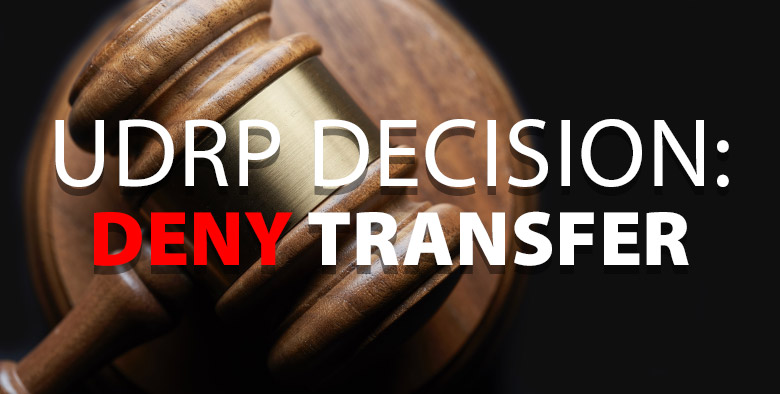The domain name SweetJames.com was part of a UDRP that involved business partners parting ways.
Registered in 2011 by the Respondent among 50 other domains, it became the law firm’s brand; in 2015 the founder and Complainant invited the Respondent as a equal (50%) partner to the firm, without requiring him to bring capital to the business.
In their filing, the Complainant attached screenshots showing that the disputed domain name was used from 2013 onward to advertise the legal services of Bergener & Associates, although it appears that the firm used bergenerlaw.com as its principal website.
That ended in 2019 with a dispute that was resolved via a settlement agreement; Complainant and Respondent had been friends and business partners for nearly 20 years in a variety of ventures, and the settlement agreement includes provisions regarding the disposition of numerous assets, including intellectual property such as the personal injury case management software that they had developed together, as well as certain named trademarks “and any associated URLs”. The 2019 Settlement Agreement says nothing, though, about the disputed domain name.
The Respondent has not been using the domain as a platform of his personal law firm but maintains control of the domain; he seeks compensation for establishing and maintaining the domain through the years.
The WIPO panelist pointed out that this is indeed a dispute between business partners, as opposed to an infringement issue and ordered the domain to remain with the Respondent.

The domain transfer was denied.
Copyright © 2025 DomainGang.com · All Rights Reserved.ARBITRATION AND MEDIATION CENTER
ADMINISTRATIVE PANEL DECISION
Sweet James LLP v. Samuel Mirejovsky
Case No. D2024-22781. The Parties
The Complainant is Sweet James LLP, United States of America (“United States”), represented by Hueston Hennigan LLP, United States.
The Respondent is Samuel Mirejovsky, United States, represented by Latham & Watkins LLP, United States.
2. The Domain Name and Registrar
The disputed domain name sweetjames.com is registered with NameCheap, Inc. (the “Registrar”).
3. Procedural History
The Complaint was filed with the WIPO Arbitration and Mediation Center (the “Center”) on June 3, 2024. On June 4, 2024, the Center transmitted by email to the Registrar a request for registrar verification in connection with the disputed domain name. On June 4, 2024, the Registrar transmitted by email to the Center its verification response confirming that the Respondent is listed as the registrant and providing the contact details.
The Center verified that the Complaint satisfied the formal requirements of the Uniform Domain Name Dispute Resolution Policy (the “Policy” or “UDRP”), the Rules for Uniform Domain Name Dispute Resolution Policy (the “Rules”), and the WIPO Supplemental Rules for Uniform Domain Name Dispute Resolution Policy (the “Supplemental Rules”).
In accordance with the Rules, paragraphs 2 and 4, the Center formally notified the Respondent of the Complaint, and the proceedings commenced on June 14, 2024. In accordance with the Rules, paragraph 5, the due date for Response was July 8, 2024. The Response was filed with the Center on July 8, 2024.
The Center appointed a panelist who subsequently had to be replaced, necessitating a delay in the proceeding. The Center then appointed W. Scott Blackmer as the sole panelist in this matter on September 25, 2024. The Panel finds that it was properly constituted. The Panel has submitted the Statement of Acceptance and Declaration of Impartiality and Independence, as required by the Center to ensure compliance with the Rules, paragraph 7.
4. Factual Background
The Complainant is a personal injury law firm based in Newport Beach, California, United States, organized as a limited liability partnership under California law. The Complainant’s name derives from the nickname “Sweet James” of its founding partner James Bergener. Mr. Bergener remains an active member in this firm that has grown into a leading Southern California accident practice of some 380 legal professionals, including 50 attorneys, with approximately 8,500 current clients. The record shows that Mr. Bergener and his associates have used the name SWEET JAMES as a mark identifying this legal practice, even as the practice has been reorganized in a succession of legal entities. According to the declaration of its current managing partner, the firm spends “millions” annually on advertising and marketing, including online advertising and communications via its website, which is, curiously, associated with the disputed domain name, as discussed further below. This website attracts more than 100,000 monthly visitors and advertises the qualifications and services of Mr. Bergener and the other members of the Complainant law firm.
The Complainant holds United States Trademark Registration Number 4723659 for SWEET JAMES as a standard-character mark (registered on April 21, 2015) in International Class 45, for legal services. One of the Complainant’s predecessors, Bergener & Associates, A Professional Corporation (“Bergener & Associates”) applied for this registration on September 12, 2014, claiming first use in commerce as early as June 2011.
The Respondent Samuel Mirejovsky is also a personal injury lawyer, a founding partner in a smaller firm called Sam & Ash Injury Law based in Newport Beach, California, with an office in Las Vegas, Nevada, United States. The firm has a website at “www.samandashlaw.com”.
Before the Respondent became a lawyer, he worked as a non-lawyer administrator for several years for Mr. Bergener’s then law firm, Bergener & Associates. During that time, the Respondent registered the disputed domain name.
The Registrar reports that the disputed domain name was created on July 14, 2011, and is registered to the Respondent. No organization is listed. The declaration of the Respondent attached to the Response states that he registered about 50 potential domain names in 2011, including the disputed domain name, with Mr. Bergener’s knowledge, for possible use in connection with the new firm that they were developing. The Respondent used his own funds and his own account with the Registrar. The Complaint attaches archived screenshots showing that the disputed domain name was used from 2013 onward to advertise the legal services of Bergener & Associates, although it appears that the firm used “www.bergenerlaw.com” as its principal website.
On June 1, 2015, after the Respondent became licensed as an attorney, he entered into a Stock Purchase Agreement with Mr. Bergener (attached to the Response) and acquired a 50% interest in a new law firm called Bergener Mirejovsky A Professional Corporation (“Bergener Mirejovsky”), succeeding to the interests of Bergener & Associates. The new law firm continued to use the domain name bergenerlaw.com for its website.
However, the Respondent and Mr. Bergener fell into disputes that resulted in litigation. This was ultimately resolved in 2019, as reflected in a Settlement and Mutual Release dated November 6, 2019 (the “2019 Settlement Agreement”). The two had been friends and business partners for nearly 20 years in a variety of ventures, and the settlement agreement includes provisions regarding the disposition of numerous assets, including intellectual property such as the personal injury case management software that they had developed together, as well as certain named trademarks “and any associated URLs”. The 2019 Settlement Agreement says nothing, though, about the disputed domain name.
At some point after the settlement, the Complainant began using the disputed domain name for its principal website and email accounts, while the Respondent has continued to maintain the registration of the disputed domain name.
The Complainant says that it “recently” learned that, while it continued to control the “general operation” of the disputed domain name, the Respondent’s personal email “was associated with the domain’s account with the registrar”. In May 2024 counsel for the Complainant sent the Respondent a letter demanding transfer of the disputed domain name. Counsel for the Respondent replied that he continued to own the disputed domain name in his personal capacity and asked if the Complainant was interested in purchasing it. This proceeding followed.
5. Parties’ Contentions
A. Complainant
The Complainant contends that it has satisfied each of the elements required under the Policy for a transfer of the disputed domain name.
Notably, the Complainant contends that the disputed domain name is identical to the SWEET JAMES trademark registered by its predecessor in interest. The record includes documentation of the assignment of this registration to the Complainant in 2020, which is also reflected in the United States Patent and Trademark Office (“USPTO”) database. The Complainant also asserts that the Respondent cannot claim any rights or legitimate interests in the disputed domain name, as the Respondent is not known by a corresponding name, acquired the disputed domain name for use in connection with the business of the Complainant’s predecessor (his then employer) and is no longer associated with the Complainant.
The Complainant insists that bad faith should be inferred in the registration as well as the use of the disputed domain name, because the Respondent was aware that the Complainant’s predecessor could pursue trademark protection for SWEET JAMES. Therefore, the Respondent likely meant to extort an excessive purchase price for the disputed domain name or use it eventually to disrupt the Complainant’s business or divert traffic to a competing website for commercial gain. The Complainant points out that the Respondent himself, as firm administrator at the time, signed documents applying to the USPTO for trademark registration 2014 on behalf of the Complainant’s predecessor, affirming that SWEET JAMES was first used in commerce in June 2011. Suspiciously, the Respondent registered the disputed domain name in July 2011, knowing that the company was beginning to use the term as a mark.
B. Respondent
The Respondent contends that the Complainant has not satisfied all three of the elements required under the Policy for a transfer of the disputed domain name. The Respondent does not dispute that the Complainant holds a trademark registration for SWEET JAMES. However, the Respondent claims “a right and legitimate interests” in the disputed domain name from his long-standing business relationship with Mr. Bergener, including a 50% interest in the Complainant’s immediate predecessor. Their 2019 Settlement Agreement did not address the disputed domain name, so the Respondent argues that the issue should be referred to the arbitration clause of the Agreement rather than addressed in a UDRP proceeding. The Respondent argues as well that the Complainant’s claims have “eroded” over time, as the Complainant has not asserted rights in the disputed domain name for years despite being aware of the Respondent’s registration. The Respondent points to repeated queries from the Registrar as an indication that the Complainant is being disingenuous in claiming that it only recently learned that the Respondent still holds the registration and is using it for email.
Finally, the Respondent denies bad faith, contending that he was a long-time business partner of Mr. Bergener, not merely an employee, seeking to build their business. Mr. Bergener recognized this by making him a 50% partner in 2015 without requiring him to bring capital to the business. The Respondent argues that he acted in good faith in 2011 by registering many domain names for potential use by the business in which he was personally invested for many years. The Respondent argues further that his subsequent conduct over many years reflects good faith. He has allowed the Complainant to continue using the disputed domain name without disruption, and he has not used the disputed domain name to redirect to the website of his own law firm. He seeks only a fair arbitration of the remaining issues, such as his costs in maintaining the disputed domain name for years, as contemplated under the Settlement Agreement.
6. Discussion and Findings
A. Identical or Confusingly Similar
It is well accepted that the first element functions primarily as a standing requirement. The standing (or threshold) test for confusing similarity involves a reasoned but relatively straightforward comparison between the Complainant’s trademark and the disputed domain name. WIPO Overview of WIPO Panel Views on Selected UDRP Questions, Third Edition, (“WIPO Overview 3.0”), section 1.7.
The Complainant has shown rights in respect of a trademark or service mark, the registered SWEET JAMES word mark, for the purposes of the Policy. WIPO Overview 3.0, section 1.2.1.
The entirety of the mark is reproduced within the disputed domain name. (The space between words in the trademark cannot be reproduced in the DNS address system.) Accordingly, the disputed domain name is identical or confusingly similar to the mark for the purposes of the Policy. WIPO Overview 3.0, section 1.7.
The Panel finds the first element of the Policy has been established.
B. Rights or Legitimate Interests
Paragraph 4(c) of the Policy provides a list of circumstances in which the Respondent may demonstrate rights or legitimate interests in a disputed domain name.
Although the overall burden of proof in UDRP proceedings is on the complainant, panels have recognized that proving a respondent lacks rights or legitimate interests in a domain name may result in the difficult task of “proving a negative”, requiring information that is often primarily within the knowledge or control of the respondent. As such, where a complainant makes out a prima facie case that the respondent lacks rights or legitimate interests, the burden of production on this element shifts to the respondent to come forward with relevant evidence demonstrating rights or legitimate interests in the domain name (although the burden of proof always remains on the complainant). If the respondent fails to come forward with such relevant evidence, the complainant is deemed to have satisfied the second element. WIPO Overview 3.0, section 2.1.
Having reviewed the available record, the Panel finds the Complainant has established a prima facie case that the Respondent lacks rights or legitimate interests in the disputed domain name. The Respondent has not rebutted the Complainant’s prima facie showing and has not come forward with any relevant evidence demonstrating rights or legitimate interests in the disputed domain name such as those enumerated in the Policy or otherwise. To the extent that the Respondent at one time may have had a claim to legitimacy as an agent, employee, or partner of a person or entity using “Sweet James” as a mark or trade name, that has not been the case for years. Rights or legitimate interests are generally assessed at the time of the UDRP proceeding. WIPO Overview 3.0, section 2.11. The Respondent himself is not known by a corresponding name, nor is his current business. The only website associated with the disputed domain name is the Complainant’s, and, by his own admission, the Respondent has not used the disputed domain name, but merely maintained its registration with his own funds. Accordingly, the only use of the disputed domain name is the Complainant’s current use, and the Respondent’s use of the disputed domain name is not in connection with a bona fide commercial offering or a noncommercial fair use.
The Panel finds the second element of the Policy has been established.
C. Registered and Used in Bad Faith
The Panel notes that, for the purposes of paragraph 4(a)(iii) of the Policy, paragraph 4(b) of the Policy establishes circumstances, in particular, but without limitation, that, if found by the Panel to be present, shall be evidence of the registration and use of a domain name in bad faith.
In the present case, the Panel notes that the Respondent was clearly aware of the Complainant’s predecessor (his employer) at the time the Respondent registered the disputed domain name. And in the unusual circumstances of this proceeding, the Respondent himself asserted in a USPTO filing more than three years later, that this entity made first commercial use of the SWEET JAMES mark a few weeks before the Respondent registered the disputed domain name.
The Complainant argues that this implies that the Respondent was playing a long game, hoping that (a) the Complainant’s predecessor would adopt SWEET JAMES as its trademark, then (b) desire to use the disputed domain name, and (c) agree to pay the Respondent a princely sum for it. The Respondent denies such an intention, and it seems improbable. In the event, it was several years before the trademark application was made, and even more years before the disputed domain name was adopted for the Complainant’s principal website. The Respondent argues that the Complainant was aware of the Respondent’s activity in registering the disputed domain name – and others – for potential use in the business, and at the Respondent’s expense, and the Complainant does not deny this. The Complainant also does not undermine the Respondent’s evidence of a long-term business relationship in which the Respondent was not merely an employee but a business partner with Mr. Bergener in software development, real estate, and other activities, as well as ultimately a 50% law partner in the successor law firm. This differs substantially from the fact pattern in UDRP decisions cited by the Complainant in which an employee or agent registers a domain name on behalf of a company, often covertly, and then attempts to sell it to the company for an extortionate price.
The evidence in the case file as presented does not indicate that the Respondent’s aim in registering the disputed domain name was to profit from or exploit the Complainant’s possible future trademark. WIPO Overview 3.0, section 3.8.1. The trademark was not established at the time the disputed domain name was registered. The Respondent possibly had knowledge that the Complainant might be in the beginning stages of considering it as a mark, but as no trademark registration application was filed for more than three years, this must be considered speculative at the time of the disputed domain name registration. In any event, the Respondent was employed with the Complainant’s predecessor at the time, friendly with its principal, devoting time and personal resources to building the business, and ultimately successful in becoming half-owner of the business based on his contributions of services. The Respondent denies an intention at that time to attack a possible future trademark, and the evidence to the contrary is not persuasive. The Panel considers it improbable that the Respondent contemplated a future break with Mr. Bergener and the option of using the disputed domain name against a possible future trademark as some kind of leverage many years later. Hence, the balance of probabilities is against bad faith at the time of registration, and the Respondent’s rather generous conduct since with respect to the disputed domain name supports that negative inference.
There is only so far that a UDRP proceeding can go in piercing the depths of a clouded and nuanced business dispute. This is obviously not a clearcut case of cybersquatting or malicious extortion by a disaffected former employee. The burden of proof rests with the Complainant in a UDRP proceeding where there is a single round of pleadings, no discovery, and no opportunity to examine witnesses, and the Complainant has not presented evidence here that overcomes the Respondent’s plausible narrative and denial of bad faith. The Parties will have to reason together or present themselves to a forum where evidence and credibility can be tested more fully.
Within the confines of the UDRP process, the Panel finds the third element of the Policy has not been established.
7. Decision
For the foregoing reasons, the Complaint is denied.
/W. Scott Blackmer/
W. Scott Blackmer
Sole Panelist
Date: October 3, 2024













